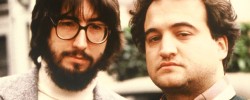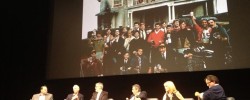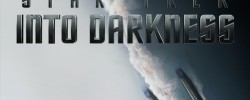
Nicolas Winding Refn: A Retrospective

Editor’s Notes: Only God Forgives opens in limited release and on VOD today.
The conversation about Nicolas Winding Refn seems to have really taken off in the last few years, after the release of his magnum opus Drive, in spite of the fact that Refn has been making films since 1996, and that many of them were incredibly successful, both critically and commercially. He has gained both ardent supporters and vehement detractors since the release of his last film, becoming a divisive but impossible to ignore figure in cinephillic circles. He is often branded as a “style over substance” director, a man with a gift for visuals making films that lack heft. Yet this criticism has always struck me as off base. Refn’s style is deliberate, calculated, and ultimately, deeply meaningful. His best films are stylistic reflections of their deeper substance, so lush and beautifully shot, so perfectly attuned to their thematic purpose, that words are almost superfluous. At his best, Refn is a sublimely visual filmmaker, rooting his stories in fitting styles and expanding them in scope without ever losing their tight focus. Despite his long, reasonably prolific career (Refn has directed 9 films, including his newest Only God Forgives), this stylized approach is actually a fairly new development, fully taking hold for the first time with 2008’s Bronson. To understand the strides Refn has made as a filmmaker, and the status he holds in cinema at the moment, it is important to look back at the trilogy that made him famous, and to examine his recent films that have cemented his innovative, compelling style of filmmaking.
The Pusher trilogy feels so separated from Refn’s recent work it is almost as if someone else entirely was behind the camera. Though there’s a bold statement of purpose to the highly stylized opening credits of each film (which show the main characters, harshly lit from above, as their names are displayed), they are ultimately fairly standard crime drama fare. This isn’t to denigrate the films, each of which has its charms, but they lack the confidence and verve of Refn’s best work. Each focuses on one character populating the criminal underworld of Copenhagen, and while the culture of the film is alien to the genre, the story beats are fairly familiar. The films are not poorly directed by any stretch, but to call them much more than competent on that front would be disingenuous. These are good movies, with good central performances (perhaps my love of Mads Mikkelsen contributes to the fact that the second film, which focuses on his character, is my favorite) and fine, even good direction. Yet nothing here bespeaks the early works of a stylistic virtuoso.
Refn truly emerged as a creative force to be reckoned with in 2008 when he released Bronson, a stylistic tour de force he has since described as a “gay opera.” The film is a biopic of Britain’s most notorious prisoner (played here by Tom Hardy, who is incredible, visceral, and darkly charismatic in the role), staged as a one-man show performed by the title character. The film is a canny mix of black comedy, pulpy horror, and smatterings of ultra violence, all displayed with a showiness and skill Refn had never previously revealed. Bronson is a showman whose art is violence, and Refn plays up the theatricality and artful brutality, turning each foe his character faces into another canvas for Bronson to destroy.
All of Refn’s films focus tightly on a central male protagonist in turmoil, caught up in violence and betrayal, cornered and asked to fight their way free, but Bronson was the first time Refn truly got in the head of one of his protagonists and transformed the world of the film into a skewed reality that reflected that viewpoint. The film hangs on Hardy’s performance, which is chaotic and brilliant in all the right ways. He can turn on a dime from meek to venomous, from docile to murderous, but he never loses the audience even as he does things that should repel us. Bronson is his show, and by putting us in the character’s headspace and showing us the world as he experiences it, Refn created his best work to that point.

Refn traded in the boisterous showiness of the stage for the quiet atmospherics of nature in Valhalla Rising. The film follows a Norse warrior called only One-Eye (Mads Mikkelsen, who is stellar without uttering a single word) who kills his masters, escapes captivity, and finds himself travelling the New World in the company of aspiring Christian Crusaders. The plot is virtually beside the point, as the film’s heights come in long, wordless sequences that revel in nature and ruminate on the violence of the culture the film depicts. Refn channels Terrence Malick here, using each shot as a canvas on which he paints a beautiful, bloody portrait of a warrior’s life. One-Eye is shown to be prophetic, and his visions come in stark reds and muddy grays, showing him bathed in bright red light as if covered in vibrant blood, while the world around him recedes into irrelevance. Where Bronson threw us into the mind of a showman by letting him tell us his story, Valhalla Rising puts us into the headspace of a warrior whose only thoughts are future actions.
There is an existential undercurrent to much of Refn’s work, but Mikkelsen’s mute man of action is his first fully successful existential hero, a man defined entirely by his actions whose silence demands he be analyzed by the audience, and whose strong, violent presence makes him an irrefutable fact to any who cross his path. If there’s a story to Valhalla Rising, it is that of a man who had his agency taken from him seizing it for himself, living as he chooses, and finally making a decision to give up his burdens. It is a gorgeous, esoteric, meandering and meaningful film where style doesn’t trump substance so much as subsume it. Those who characterize Refn’s films as empty miss their greatest implication: the meaning is in the image because the image is all we can ever know for sure. His heroes are defined not by their words but by their actions; his films are defined not by their stories but by the interior worlds they so fluidly reflect.
It makes perfect sense, then, that Refn’s best film to date focuses on one of the most resonant existential metaphors in popular culture: driving. An action film that strips the genre to its cold, hard core, Drive is also imbued with its protagonist’s quiet, yearning romanticism. The film follows a man with no name (Ryan Gosling) who is the perfect picture of the existential hero: a quiet stoic with no known past or attachments, defined only by his actions and the code he lives by. The film follows him as he becomes infatuated with his next-door neighbor (Carey Mulligan) and becomes drawn into a scheme by her convict husband that goes awry and throws his perfectly calibrated life into disarray.

A moody, contemplative film interspersed with moments of shocking violence, Drive captures the loneliness and alienation of a man living outside the law while also depicting the philosophical freedom he has by living the way he chooses. With a phenomenal supporting performance by Albert Brooks as a pragmatic sociopath, and great smaller turns by Bryan Cranston and Christina Hendricks, Drive is a film of stark power and undeniable cool, a movie that maximizes every moment and every shot, turning in a stunning study of economy in filmmaking, noir-tinged cool, and what our philosophical choices say about us as people and what we are willing to do for those we love.
The quick, economical, brutally efficient staging and editing reflect our hero’s outlook: The Driver does what he needs to do, when he needs to do it, and not a second or a shot is wasted in bringing his story to life. Everything from the soundtrack to the pacing is perfectly chosen to bring us into this man’s world and situate us in his mode of thinking, and of living. Drive is Refn’s masterpiece because it’s the apotheosis (to date, anyway) of the marriage between his stylistic boldness and its thematic resonance, a film where the line between thought and action, between the action and its representation, is razor-thin and fully immersive.
The early word on Only God Forgives (which premiered at Cannes to the festival’s trademark boos) has been largely negative, but again and again, the conversation has been peppered with the “style over substance” accusation. If the film develops a tone and feel that matches its central thematic concerns and effectively situates us within the mind of its lead in the way Refn’s last few films have so capably, it is hard to imagine the film won’t be in some sense worthwhile. And if Only God Forgives proves to be a misstep for the director, I’ll still eagerly await his next virtuoso transportation of viewers, his next complete immersion into his central characters. There’s a boldness to Refn’s recent work that people tend to find either grating or exciting. What bears recognition is the subtlety that Refn’s vibrant approach communicates, the way he merges image and meaning, viewer and protagonist, into one. Its clean, clear, original, and invigorating filmmaking from a major directorial presence.
Related Posts
Jordan Ferguson
Latest posts by Jordan Ferguson (see all)
- Review: The Spectacular Now (2013) - Essential Viewing - July 30, 2013
- Review: Only God Forgives (2013) - July 21, 2013
- Nicolas Winding Refn: A Retrospective - July 19, 2013
































